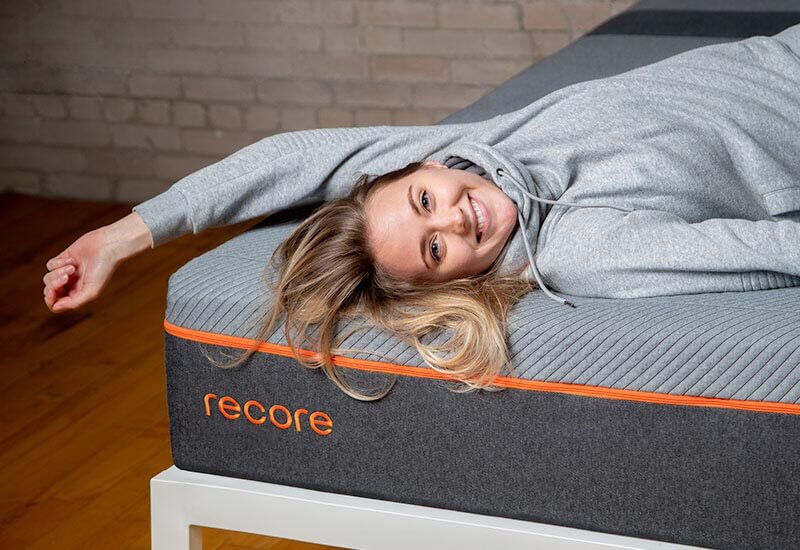On the fourth floor of the historic Burroughes Building on Toronto’s Queen Street West sits the smallest mattress showroom you can imagine. At 200 square feet, it’s the antithesis to big-box stores with dozens of options on display. This white brick-clad showroom, Endy’s, selling just one style of mattress, looks like the kind of warehouse a guest character on Girls would live in. The Toronto-based startup entered the rising, already competitive direct-to-consumer bed-in-a-box online market a year ago with its eyes set on the coveted, tech-savvy consumer. “It’s the same generation that’s using Uber and Airbnb. It comes down to convenience, being able to shop online and compare different options,” co-founder and CEO Mike Gettis says.
What this means for the industry is that the old-fashioned way of marketing mattresses – think of those Sleep Country Canada ads with people being interviewed on beds – won’t work any more. Enter the hipster mattress, a bed in a box with celebrity buzz and strong social-media presence.
Endy trumpets its Canadian manufacturing, which Gettis credits as a factor in keeping low costs on a high-quality product, saving by streamlining their production chain and by eliminating the wholesaler and the retailer. “Plus, with the state of the Canadian dollar, it’s more economical to produce stuff here,” he says.
Endy’s memory-foam mattress ranges from $650 for the twin size to $850 for the king, making it among the more affordable options on the market.
New York-based Casper had buzz from the beginning, helped along by celebrity investors Ashton Kutcher and Leonardo DiCaprio. It launched in 2014 with a one-style-fits-all mattress in a slick sailor-striped box that has made cameos on celebrity Instagram accounts, including Kylie Jenner’s as well as that of indie darling, Girls actress Gillian Jacobs. Like Endy, Casper comes with an affordable price tag, with the king size priced at $950 (U.S.).
Casper
Last December, Casper took part in Art Basel Miami, collaborating with artist Colin Snapp and Master & Dynamic headphones on Quiet Rooms, a series of safari tents outfitted with Casper mattresses and bedding that exhibition-goers were invited into for a quick rest. Sleep has become a hot topic as recent reports have identified that a greater number of young professionals are suffering from sleep disorders. In the 2015 Newsweek cover story titled Our Sleep Problem and What to Do About It, author Betsy Isaacson attributes the millennial sleep issues to the changing economy and work culture. She cites the findings from the 2014 Millennial Study conducted by Harris Poll on behalf of Wells Fargo, which reports that 40 per cent of young people in America hold non-permanent positions at their places of work. Isaacson’s article suggests that smartphone dependence and constant connectivity is a significant factor in the quality of sleep.
To address the sleep epidemic, Casper also launched an online sleep-wellness site, Van Winkle’s. They aren’t alone in targeting this generation’s sleeplessness: Ariana Huffington has embarked on a college tour to promote her new book, The Sleep Revolution, in which she describes the millennial generation as the most stressed and sleep-deprived. Even Hastens, a luxury mattress giant, is jumping to reach the fatigued demographic by collaborating with Spotify on a series of sleep-aid playlists. If you’re under 35, you may also find sleep on offer at work. Cool/hipster workplaces are now offering nap rooms, says Andrea Baxter, founder of Bratface Marketing. “Having a 15- to 30-minute power nap in the middle of the day is becoming more prevalent.”
Casper’s aspirational marketing has also managed to imbue a product in the “economy” category with cachet. For proof, see the hundreds of “unboxing” vidoes on YouTube and social-media channels. The mattress, which is vacuum-packed into a compact metre-tall box, expands to its full size within minutes of its release. “It becomes kind of an iconic moment when you buy your Casper mattress,” says Nicole Tapscott, the company’s general manager for Canada.
Endy
In some ways, the bed-in-a-box was just waiting to happen. Edmonton-based Novosbed was an early pioneer and paved the way for companies such as Endy and Casper. Andy Prochazka and his twin brother, Sam, launched Novosbed in 2009, offering three different mattress options: firm, medium and soft.
Geared at Generation X, they offered a generous 100-plus-day return policy, a far cry from the traditional way of sampling a mattresses while fully clothed and wide awake in a big-box store. That policy made their product a low-risk investment, resonating with the early online mattress buyers and set the precedent for other companies, including Casper and Endy.
“Casper really blew the market open to a younger buying demographic in 2014,” Andy Prochazka says. Novosbed actually benefited from Casper’s launch, gaining costumers who were looking for a higher-end option that could be easily ordered and delivered to their door. By his count, at least 27 similar bed-in-a-box businesses such as Leesa, Yogabed and Tuft & Needle have rolled out since.
Prochazka also points out that traditional mattress brands have been trying to catch up with the boxed trend, with Mattress Firm’s Dream Bed and Tempur Sealy’s Cacoon. They look just as hip, but lack the cool factor of a startup company. “It feels disingenuous,” says Prochazka.
The demand for straight-to-consumer product sees no signs of slowing down. The online customer satisfaction reviews of Novosbed, Casper and Endy rank high, with few returns (which are usually donated to their respective charities). According to Gettis, just a couple of years ago “online sales made for about 2 per cent of the mattress market, and it’s grown to about 5 per cent.” Thanks to an exhausted generation of young people, that’s projected to grow, “to between 15 and 20 per cent in the next two to three years.”

Recent Comments